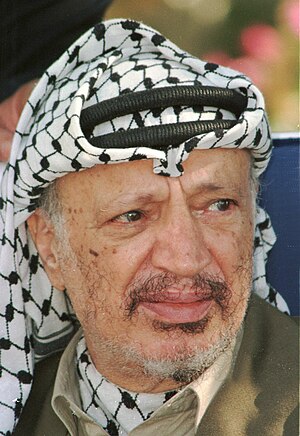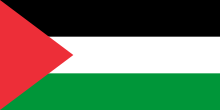Người Palestin

الفلسطينيون | |
|---|---|
 | |
| Tổng dân số | |
| 14,3 triệu[4] | |
| Khu vực có số dân đáng kể | |
| 5,350,000[4] | |
| – Bờ Tây | 3.190.000[4] (cho tới năm 2017, 809.738 người trong số này đăng ký tị nạn)[5][6][7] |
| – Dải Gaza | 2.170.000 (cho tới năm 2018, 1.386.455 người trong số này đăng ký tị nạn)[4][5][6][8] |
| 2.175.491 (2017, chỉ bao gồm những người đăng ký tị nạn)[5]–3,240,000 (2009)[9] | |
| 2.037.000 [10] | |
| 568.530 (2021, chỉ bao gồm những người đăng ký tị nạn)[5] | |
| 500.000[11] | |
| 400.000[12] | |
| 295.000[12] | |
| 255.000[13] | |
| 200.000[14] | |
| 174.000 (2017 census)[15]–458,369 (2016, registered refugees)[5] | |
| 27.000–200.000[12][16] | |
| 100.000[17] | |
| 80.000[18] | |
| 70.000[12] | |
| 70.000[19] | |
| 59.000[20] | |
| 59.000[12] | |
| 57.000[21] | |
| 50.975[22] | |
| 29.000[12] | |
| 20.000[23] | |
| 15.000[cần dẫn nguồn] | |
| 13.000[12] | |
| 12.000[12] | |
| 9.000–15.000[24] | |
| 7.000[25][26] | |
| 7.000[27] | |
| 4.030[28] | |
| Ngôn ngữ | |
| Ở Palestine và Israel: Tiếng Ả Rập, Tiếng Hebrew, Tiếng Anh Kiều dân: các phương ngữ tiếng Ả Rập địa phương và những ngôn ngữ khác ở các nước sở tại của kiều dân Palestin | |
| Tôn giáo | |
| Đa số: Hồi giáo Sunni Thiểu số: Kitô giáo, Hồi giáo không hệ phái, Druze, Samaritan giáo,[29][30] Hồi giáo Shia[31] | |
| Sắc tộc có liên quan | |
| Người Jordan, Người Liban, Người Syria và các dân tộc Ả Rập khác[32] | |
Người Palestin (phát âm tiếng Việt như là: người Pa-le-xtin hay Pa-lét-xtin; tiếng Ả rập: الفلسطينيون, al-Filasṭīniyyūn hay الشعب الفلسطيني, ash-sha'b al-Filasṭīnī; tiếng Do Thái: פָלַסְטִינִים, Fālasṭīnīm hay còn gọi là người Palestin Ả rập/ العرب الفلسطينيون, al-ʿArab al-Filasṭīniyyūn) là một nhóm người Ả Rập[33][34] có nguồn gốc từ những người đã sinh sống lâu đời ở vùng Palestine trong nhiều thiên niên kỷ.[35][36][37][38][39][40][41][42][43][44][45][46][47][48] Bất chấp nhiều cuộc chiến tranh và cuộc di cư khác nhau, khoảng một nửa dân số Palestine trên thế giới vẫn tiếp tục cư trú trên lãnh thổ của Palestine trước đây, hiện bao gồm Bờ Tây và Dải Gaza (các lãnh thổ của người Palestine) cũng như ở Israel[49]. Năm 1919, người Hồi giáo Palestine và người Cơ đốc giáo Palestine chiếm 90% dân số Palestine, ngay trước làn sóng nhập cư Do Thái thứ ba dưới sự ủy trị của Anh sau Thế chiến thứ nhất.[50][51] Sự phản đối việc nhập cư của người Do Thái đã thúc đẩy việc củng cố bản sắc dân tộc thống nhất, mặc dù xã hội Palestine vẫn bị chia rẽ từ những khác biệt về khu vực, giai cấp, tôn giáo và gia đình[52][53].
Lịch sử bản sắc dân tộc Palestine là một vấn đề gây tranh cãi giữa các học giả,[54] thuật ngữ "Palestin" được người Ả Rập Palestine sử dụng để chỉ khái niệm dân tộc chủ nghĩa về một dân tộc Palestine từ cuối thế kỷ 19 và trước Thời kỳ Thế chiến thứ nhất. Sự giải thể của Đế chế Ottoman và sau đó là việc thành lập một chính quyền ủy trị của Anh cho khu vực đã thay thế quốc tịch Ottoman bằng quốc tịch Palestine, củng cố bản sắc dân tộc. Sau Tuyên ngôn Độc lập của Israel, việc trục xuất người Palestine năm 1948, và hơn thế nữa sau cuộc di cư của người Palestine năm 1967, thuật ngữ "Palestin" đã phát triển thành ý nghĩa về một tương lai chung dưới hình thức khát vọng về một nhà nước Palestine[46] Ngày nay, bản sắc Palestine bao gồm di sản của mọi thời đại từ thời Kinh thánh cho đến thời kỳ Ottoman.
Được thành lập vào năm 1964, Tổ chức Giải phóng Palestine (PLO) là một tổ chức bảo trợ cho các nhóm đại diện cho người dân Palestine trước các quốc gia trên trường quốc tế[55]. Chính quyền Quốc gia Palestine chính thức được thành lập vào năm 1994 theo Hiệp định Oslo, là một cơ quan hành chính lâm thời chịu trách nhiệm quản lý trên danh nghĩa các trung tâm dân cư Palestine ở Bờ Tây và Dải Gaza[56]. Kể từ năm 1978, Liên hợp quốc đã tổ chức Ngày Quốc tế đoàn kết hàng năm với nhân dân Palestine. Theo nhà sử học người Anh Perry Anderson, người ta ước tính rằng một nửa dân số ở các vùng lãnh thổ Palestine là người tị nạn Palestine, và họ đã phải chịu thiệt hại chung về tài sản khoảng 300 tỷ USD do sự tịch thu tài sản từ phía Israel, tính theo thời giá năm 2008–2009[57].
Tham khảo
[sửa | sửa mã nguồn]- Al-Ali, Nadje; Koser, Khalid (2004). New Approaches to Migration?: Transnational Communities and the Transformation of Home. Taylor & Francis. ISBN 978-0203167144.
- Ankori, Gannit (2006). Palestinian Art. Reaktion Books. ISBN 978-1861892591.
- Barzilai, Gad. (2003). Communities and Law: Politics and Cultures of Legal Identities. Ann Arbor: University of Michigan Press. ISBN 0-472-11315-1
- Boyle, Kevin and Sheen, Juliet (1997). Freedom of Religion and Belief: A World Report. London: Routledge. ISBN 0-415-15977-6
- Cohen, Getzel M. (2006). The Hellenistic settlements in Syria, the Red Sea Basin, and North Africa . University of California Press. ISBN 978-0520931022.
- Cohen, Hillel, Army of Shadows, Palestinian Collaboration with Zionism, 1917–1948
- Cohen, Robin (1995). The Cambridge Survey of World Migration. Cambridge University Press. ISBN 0-521-44405-5
- Cordesman, Anthony H (2005). The Israeli-Palestinian War: Escalating to Nowhere. Greenwood Publishing Group. ISBN 0-275-98758-2
- Drummond, Dorothy Weitz (2004). Holy Land, Whose Land?: Modern Dilemma, Ancient Roots. Fairhurst Press. ISBN 0-9748233-2-5
- Farsoun, Samih K. (2004). Culture and Customs of the Palestinians. Greenwood Press. ISBN 0-313-32051-9
- Feldman, Louis H. (1990). “Some Observations on the Name of Palestine”. Hebrew Union College Annual. Hebrew Union College – Jewish Institute of Religion. 61: 1–23. JSTOR 23508170.
- Feldman, Louis (1996). “Some Observations on the Name of Palestine”. Studies in Hellenistic Judaism. BRILL. tr. 553–576. ISBN 9789004104181. Truy cập ngày 17 tháng 10 năm 2014.
- Gelvin, James L (2005). The Israel-Palestine Conflict: One Hundred Years of War. Cambridge University Press, New York, NY. ISBN 0-521-85289-7
- Greenfield, Jonas C.; Paul, Shalom M.; Stone, Michael E; Pinnick, Avital (2001). Al Kanfei Yonah: Collected Studies of Jonas C. Greenfield on Semitic Philology . BRILL. ISBN 978-9004121706.
- Guzmán, Roberto Marín (2000). A Century of Palestinian Immigration into Central America. Editorial Universidad de C.R. ISBN 9977-67-587-2
- Healey, John F. (2001). The Religion of the Nabataeans: A Conspectus. Brill Academic Publishers. ISBN 90-04-10754-1
- Hobsbawn, Eric (1990). Nations and Nationalism since 1780: Programme, myth, reality. Cambridge University Press.
- Howell, Mark (2007). What Did We Do to Deserve This? Palestinian Life under Occupation in the West Bank, Garnet Publishing. ISBN 1-85964-195-4
- Jacobs, Daniel; Eber, Shirley; Silvani, Francesca (1998). Israel and the Palestinian Territories: the rough guide. London: Rough Guides. ISBN 978-1-85828-248-0.
- Jacobson, David (2001), “When Palestine Meant Israel”, Biblical Archaeology Review, 27 (3)
- Karmi, Ghada (2005). In Search of Fatima: A Palestinian Story. Verso. ISBN 978-1-85984-694-0.
- Kasher, Aryeh (1990). Jews and Hellenistic Cities in Eretz-Israel. Mohr Siebeck. ISBN 3-16-145241-0
- Khalidi, Rashid (1997). Palestinian Identity: The Construction of Modern National Consciousness. Columbia University Press. ISBN 0-231-10514-2
- “Beshara Doumani's "Rediscovering Ottoman Palestine: Writing Palestinians into History” (PDF). Bản gốc (PDF) lưu trữ ngày 6 tháng 11 năm 2007. Truy cập ngày 18 tháng 8 năm 2013.
- McCarthy, Justin (1994). “Palestine's Population During The Ottoman And The British Mandate Periods”. Journal of the American Oriental Society. 114: 106–107. doi:10.2307/604972. JSTOR 604972.
- Khalidi, Rashid (2006). The Iron Cage: The Story of the Palestinian Struggle for Statehood, Houghton Mifflin. ISBN 0-8070-0308-5
- Khalidi, Walid (1984). Before Their Diaspora. Institute for Palestine Studies, Washington D.C.
- Kimmerling, Baruch and Joseph S. Migdal (2003). The Palestinian People: A History. Harvard University Press. ISBN 0-674-01129-5. ISBN 978-0-674-01129-8.
- Kish, George (1978). A Source Book in Geography . Harvard University Press. ISBN 978-0674822702.
- Kunstel, Marcia and Joseph Albright (1990). Their Promised Land: Arab and Jew in History's Cauldron-One Valley in the Jerusalem Hills. Crown. ISBN 0-517-57231-1
- Lewis, Bernard (1999). Semites and Anti-Semites: An Inquiry Into Conflict and Prejudice. W. W. Norton & Company. ISBN 0-393-31839-7
- Lewis, Bernard (2002). The Arabs in History. Oxford University Press, USA, 6th ed. freedomofbleep.com
- Lybarger, Loren (2007). Identity and religion in Palestine: the struggle between Islamism and secularism in the occupied territories. Princeton University Press, ISBN 978-0-691-12729-3
- Lynd, S., Bahour, S. and Lynd, A. (editors) Homeland: Oral Histories of Palestine and Palestinians. New York: Olive Branch Press. ISBN 1-56656-132-9
- McCarthy, Justin (1990). "The Population of Palestine: Population Statistics of the Late Ottoman Period and the Mandate". Columbia University Press, ISBAN: 0231071108
- McDowall, David (1989). The Uprising and Beyond. I.B.Tauris. ISBN 1-85043-289-9
- Muhawi, Ibrahim (1989). Speak, Bird, Speak Again: Palestinian Arab Folktales. University of California Press. ISBN 978-0-520-06292-4
- Parkes, James (1970). Whose Land? A History of the Peoples of Palestine.
- Parmenter, Barbara McKean (1994). Giving Voice to Stones Place and Identity in Palestinian Literature University of Texas Press
- Porath, Yehoshua (1974). The Emergence of the Palestinian-Arab National Movement 1918–1929. London: Frank Cass and Co., Ltd. ISBN 0-7146-2939-1
- Porath, Yehoshua (1977). Palestinian Arab National Movement: From Riots to Rebellion: 1929–1939, vol. 2, London: Frank Cass and Co., Ltd.
- Shahin, Mariam (2005). Palestine: A Guide. Interlink Books.
- Schulz, Helena Lindholm; Hammer, Juliane (2003). The Palestinian Diaspora: Formation of Identities and Politics of Homeland. Routledge. ISBN 978-0-415-26820-2.
- Whitelam, Keith (1997). The Invention of Ancient Israel: The Silencing of Palestinian History, Routledge, ISBN 0-415-10759-8, ISBN 978-0-415-10759-4
- Charles Wilson, "Picturesque Palestine, Sinai and Egypt". New York, 1881.
- Semino; và đồng nghiệp (2004). “Origin, Diffusion, and Differentiation of Y-Chromosome Haplogroups E and J: Inferences on the Neolithization of Europe and Later Migratory Events in the Mediterranean Area”. American Journal of Human Genetics. 74 (5): 1023–1034. doi:10.1086/386295. PMC 1181965. PMID 15069642.
- Ateek, Naim (1992) Jerusalem in Islam and For Palestinian Christians.
Liên kết ngoài
[sửa | sửa mã nguồn]- Christians in Palestine antique prints collection
- Sounds of Folksongs Lưu trữ 2 tháng 7 năm 2020 tại Wayback Machine
- Voice of Palestinian Folklore, Free Songs Download Lưu trữ 25 tháng 7 năm 2020 tại Wayback Machine
- Traditional Palestinian Clothes
- The Art of Palestinian Embroidery
- Sands of Sorrow – Film on refugees
- United Nations Programme of Assistance to the Palestinian People Lưu trữ 4 tháng 7 năm 1997 tại Wayback Machine
- The Ottoman Palestine Download Palestinian Pictures in Ottoman Palestine.
Chú thích
[sửa | sửa mã nguồn]- ^ Yasser Arafat - Cuộc đời và Sự nghiệp — RFA Tiếng Việt
- ^ Yasser Arafat và những kỉ niệm Việt Nam - Sở Ngoại vụ tỉnh An Giang
- ^ Lời tựa của Đại tướng Mai Chí Thọ trong cuốn Arafat - Một đời cho tự do - Tổng hợp và biên dịch Fist News, Nhà xuất bản tổng hợp Thành phố Hồ Chí Minh, năm 2004, trang 5
- ^ a b c d ’Palestinian Central Bureau of Statistics (PCBS) Presents the Conditions of Palestinian Populations on the Occasion of the International Population Day, 11/07/2022,’ Palestinian Central Bureau of Statistics (PCBS) 7 July 2022
- ^ a b c d e “Where We Work UNRWA”. UNRWA.
- ^ a b 'PCBS reports Palestinian population growth to 4.81 million,' Lưu trữ 13 tháng 7 năm 2016 tại Wayback Machine Ma'an News Agency 11 July 2016.
- ^ 'The World Fact Book CIA July 2015.
- ^ 'PCBS: The Palestinians at the end of 2015,' Lưu trữ 2023-05-03 tại Wayback Machine 30 December 2015
- ^ “Palestinian Central Bureau of Statistics (PCBS) Press Release” (PDF). Bản gốc (PDF) lưu trữ ngày 10 tháng 10 năm 2017. Truy cập ngày 30 tháng 10 năm 2023.
- ^ ‘Israel’s population approaches 9.7 million as 2022 comes to an end,’ Times of Israel 10 December 2022
- ^ Lỗi chú thích: Thẻ
<ref>sai; không có nội dung trong thẻ ref có tênlaventana1 - ^ a b c d e f g h “The Arab, Palestinian people group is reported in 25 countries”. Joshua Project. Truy cập ngày 26 tháng 6 năm 2016.
- ^ “U.S. Census website”. United States Census Bureau. Truy cập ngày 22 tháng 4 năm 2009.
- ^ “Palestinians Living in UAE Uncertain Over Peace Deal With Israel”. The Media Line. 16 tháng 8 năm 2020.
- ^ “Lebanon conducts first-ever census of Palestinian refugees”. 21 tháng 12 năm 2017.
- ^ Jorge Alberto Amaya, Los Árabes y Palestinos en Honduras: su establecimiento e impacto en la sociedad hondureña contemporánea:1900–2009 Lưu trữ 18 tháng 8 năm 2016 tại Wayback Machine 23 July 2015.'En suma, los árabes y palestinos, arribados al país a finales del siglo XIX, dominan hoy en día la economía del país, y cada vez están emergiendo como actores importantes de la clase política hondureña y forman, después de Chile, la mayor concentración de descendientes de palestinos en América Latina, con entre 150,000 y 200,000 personas.'
- ^ “Inside Berlin's famous Palestinian neighbourhood”. Middle East Eye.
- ^ “Palestinians Open Kuwaiti Embassy”. Al Monitor. 23 tháng 5 năm 2013. Bản gốc lưu trữ ngày 22 tháng 5 năm 2013. Truy cập ngày 23 tháng 5 năm 2013.
- ^ “El Salvador's Palestinian connection”. 26 tháng 2 năm 2006.
- ^ “test0.com”. Bản gốc lưu trữ ngày 23 tháng 3 năm 2009.
- ^ “Factsheet: Palestinian Refugees in Iraq”. Bản gốc lưu trữ ngày 20 tháng 7 năm 2009. Truy cập ngày 16 tháng 6 năm 2009.
- ^ “Ethnic Origin (247), Single and Multiple Ethnic Origin Responses (3) and Sex (3) for the Population of Canada, Provinces, Territories, Census Metropolitan Areas and Census Agg.”. 2.statcan.ca. Bản gốc lưu trữ ngày 12 tháng 7 năm 2020. Truy cập ngày 22 tháng 4 năm 2009.
- ^ “The Palestinian Diaspora in Europe”. Bản gốc lưu trữ ngày 24 tháng 8 năm 2013. Truy cập ngày 22 tháng 6 năm 2011.
- ^ “Did you know that ... Palestinians in the Netherlands – Palestine Link”. Bản gốc lưu trữ ngày 4 tháng 11 năm 2018. Truy cập ngày 4 tháng 11 năm 2018.
- ^ “Handing on the key” (PDF). Bản gốc (PDF) lưu trữ ngày 2 tháng 11 năm 2012. Truy cập ngày 21 tháng 5 năm 2011.
- ^ “Australians' Ancestries” (PDF).
- ^ Miguel Benito. “Palestinier”. Bản gốc lưu trữ ngày 29 tháng 7 năm 2013.
- ^ “2013 UNHCR country operations profile – Algeria”. United Nations High Commissioner for Refugees. 2013. Truy cập ngày 22 tháng 12 năm 2013.
- ^ Mor, M., Reiterer, F. V., & Winkler, W. (2010). Samaritans: Past and present: Current studies. Berlin: De Gruyter. p. 217.
- ^ Miller, Elhanan (26 tháng 4 năm 2013). “Clinging to ancient traditions, the last Samaritans keep the faith”. The Times of Israel. Truy cập ngày 16 tháng 2 năm 2016.
- ^ Chapter 1: Religious Affiliation retrieved 4 September 2013
- ^ Hajjej, Abdelhafidh; Almawi, Wassim Y.; Arnaiz-Villena, Antonio; Hattab, Lasmar; Hmida, Slama (9 tháng 3 năm 2018). “The genetic heterogeneity of Arab populations as inferred from HLA genes”. PLOS ONE (bằng tiếng Anh). 13 (3): e0192269. Bibcode:2018PLoSO..1392269H. doi:10.1371/journal.pone.0192269. ISSN 1932-6203. PMC 5844529. PMID 29522542.
- ^ “Palestine Nationalism: A. Search for Roots”. The New York Times (bằng tiếng Anh). 19 tháng 2 năm 1978. ISSN 0362-4331. Truy cập ngày 23 tháng 9 năm 2023.
The Palestinians are an Arab people, largely Moslem but with important numbers of Christians, who live in, once lived in, or trace their descent through parents or grandparents to the land once known as Palestine, which came under a British mandate in 1922 and now is the land of Israel, the West Bank of the Jordan and the Gaza Strip.
- ^ Yakobson, Alexander; Rubinstein, Amnon (2009). Israel and the Family of Nations: The Jewish Nation-state and Human Rights (bằng tiếng Anh). Taylor & Francis. tr. 179. ISBN 978-0-415-46441-3.
Of course, the notion that the Palestinians are an Arab people, an integral part of the Arab world ('the Arab nation'), is wholly legitimate and natural, given the history and culture of the people in question.
- ^ Wittes, Tamara Cofman. 2005. How Israelis and Palestinians Negotiate: A Cross-cultural Analysis. US Institute of Peace Press. p. 5. "But given that the groups we are concerned with (Israelis and Palestinians) are ethnonational groups, their political cultures are heavily shaped by their ethnonational identities."
- ^ Jabareen, Hassan. 2002. "The Future of Arab Citizenship in Israel:Jewish-Zionist Time in as Place with No Palestinian memory." In Challenging Ethnic Citizenship: German and Israeli Perspectives on Immigration, edited by D. Levy and Y. Weiss. Berghahn Books. p. 214. "This blurring has led to a situation in which characteristics of the State of Israel are presented as characteristics of a nation-state, even though (de facto) it is a binational state, and Palestinian citizens are presented as an ethnic minority group although they are a homeland majority."
- ^ Hussain, Mir Zohair, and Stephan Shumock. 2006. "Ethnonationalism: A Concise Overview." In Perspectives on Contemporary Ethnic Conflict: Primal Violence Or the Politics of Conviction, edited by S. C. Saha. Lexington Books. pp. 269ff, 284: "The Palestinians...are an ethnic minority in their country of residence."
- ^ Nasser, Riad. 2013. Palestinian Identity in Jordan and Israel: The Necessary “Others” in the Making of a Nation. Routledge: "What is noteworthy here is the use of a general category 'Arabs,' instead of a more specific one of 'Palestinians.' By turning to a general category, the particularity of Palestinians, among other ethnic and national groups, is erased and in its place Jordanian identity is implanted."
- ^ Haklai, Oded (15 tháng 6 năm 2011). Palestinian Ethnonationalism in Israel (bằng tiếng Anh). University of Pennsylvania Press. ISBN 978-0-8122-0439-1.
...throughout the 1990s and 2000s a growing number of PAI political organizations have been increasingly promoting Palestinian consciousness, advancing ethnonationalist objectives, and demanding recognition of collective group rights.
- ^ Abu-Rayya, Hisham Motkal; Abu-Rayya, Maram Hussien (2009). “Acculturation, religious identity, and psychological well-being among Palestinians in Israel”. International Journal of Intercultural Relations. 33 (4): 325–331. doi:10.1016/j.ijintrel.2009.05.006.
- ^ Moilanen-Miller, Heather. “The Construction of Identity through Tradition: Palestinians in the Detroit Metro Area”. International Journal of Interdisciplinary Social Science: 143–150. Bản gốc lưu trữ ngày 10 tháng 10 năm 2017. Truy cập ngày 2 tháng 12 năm 2015.
- ^ Wilmer, Franke (15 tháng 1 năm 2021). Breaking Cycles of Violence in Israel and Palestine: Empathy and Peacemaking in the Middle East (bằng tiếng Anh). Rowman & Littlefield. tr. 14. ISBN 978-1-7936-2352-2.
People know who they are, where they live, and where their families have lived for centuries or millennia
- ^ Dowty, Alan (2008). Israel/Palestine. London, UK: Polity. tr. 221. ISBN 978-0-7456-4243-7.
Palestinians are the descendants of all the indigenous peoples who lived in Palestine over the centuries; since the seventh century, they have been predominantly Muslim in religion and almost completely Arab in language and culture.
- ^ Abu-Libdeh, Bassam, Peter D. Turnpenny, and Ahmed Teebi. 2012. "Genetic Disease in Palestine and Palestinians." Pp. 700–11 in Genomics and Health in the Developing World, edited by D. Kumar. Oxford University Press. p. 700: "Palestinians are an indigenous people who either live in, or originate from, historical Palestine.... Although the Muslims guaranteed security and allowed religious freedom to all inhabitants of the region, the majority converted to Islam and adopted Arab culture."
- ^ Khalidi, Rashid Ismail, et al. [1999] 2020. "Palestine § From the Arab Conquest to 1900." Encyclopædia Britannica. "The process of Arabization and Islamization was gaining momentum there. It was one of the mainstays of Umayyad power and was important in their struggle against both Iraq and the Arabian Peninsula.... Conversions arising from convenience as well as conviction then increased. These conversions to Islam, together with a steady tribal inflow from the desert, changed the religious character of Palestine's inhabitants. The predominantly Christian population gradually became predominantly Muslim and Arabic-speaking. At the same time, during the early years of Muslim control of the city, a small permanent Jewish population returned to Jerusalem after a 500-year absence."
- ^ a b “Palestine”. Encyclopædia Britannica. 2007. Truy cập ngày 29 tháng 8 năm 2007.
The Arabs of Palestine began widely using the term Palestinian starting in the pre–World War I period to indicate the nationalist concept of a Palestinian people. But after 1948—and even more so after 1967—for Palestinians themselves the term came to signify not only a place of origin but also, more importantly, a sense of a shared past and future in the form of a Palestinian state.
- ^ Bernard Lewis (1999). Semites and Anti-Semites, An Inquiry into Conflict and Prejudice. W.W. Norton and Company. tr. 169. ISBN 978-0-393-31839-5.
- ^ Parkes, James. [1949] 1970. Whose Land? A History of the Peoples of Palestine (rev. ed.) Penguin. pp. 209–10: "the word 'Arab' needs to be used with care. It is applicable to the Bedouin and to a section of the urban and effendi classes; it is inappropriate as a description of the rural mass of the population, the fellaheen. The whole population spoke Arabic, usually corrupted by dialects bearing traces of words of other origin, but it was only the Bedouin who habitually thought of themselves as Arabs. Western travelers from the sixteenth century onwards make the same distinction, and the word 'Arab' almost always refers to them exclusively.... Gradually it was realized that there remained a substantial stratum of the pre-Israelite peasantry, and that the oldest element among the peasants were not 'Arabs' in the sense of having entered the country with or after the conquerors of the seventh century, had been there already when the Arabs came."
- ^ Melvin Ember; Carol R. Ember; Ian A. Skoggard (2005). Encyclopedia of Diasporas: Immigrant and Refugee Cultures Around the World. Springer. tr. 234–. ISBN 978-0-306-48321-9. Truy cập ngày 2 tháng 5 năm 2013.
- ^ Kathleen Christison, Perceptions of Palestine: Their Influence on U.S. Middle East Policy, University of California Press, 2001 p.32.
- ^ Alfred J. Andrea, James H. Overfield, The Human Record: Sources of Global History, Volume II: Since 1500, Cengage Learning, 2011 7th.ed. op,437.
- ^ Rashid Khalidi,pp.24–26
- ^ Paul Scham, Walid Salem, Benjamin Pogrund (eds.),Shared Histories: A Palestinian-Israeli Dialogue, Left Coast Press, 2005 pp.69–73.
- ^ Gelvin, James L. (13 tháng 1 năm 2014). The Israel-Palestine Conflict: One Hundred Years of War. Cambridge University Press. tr. 93. ISBN 978-1-107-47077-4.
Palestinian nationalism emerged during the interwar period in response to Zionist immigration and settlement. The fact that Palestinian nationalism developed later than Zionism and indeed in response to it does not in any way diminish the legitimacy of Palestinian nationalism or make it less valid than Zionism. All nationalisms arise in opposition to some "other". Why else would there be the need to specify who you are? And all nationalisms are defined by what they oppose. As we have seen, Zionism itself arose in reaction to anti-Semitic and exclusionary nationalist movements in Europe. It would be perverse to judge Zionism as somehow less valid than European anti-Semitism or those nationalisms. . . Furthermore, Zionism itself was also defined by its opposition to the indigenous Palestinian inhabitants of the region. Both the "conquest of land" and the "conquest of labor" slogans that became central to the dominant strain of Zionism in the Yishuv originated as a result of the Zionist confrontation with the Palestinian "other".
- ^ “Who Represents the Palestinians Officially Before the World Community?”. Institute for Middle East Understanding. 2007. Bản gốc lưu trữ ngày 28 tháng 9 năm 2007. Truy cập ngày 27 tháng 7 năm 2007.
- ^ “Palestinian Authority definition”. TheFreeDictionary.com. Truy cập ngày 6 tháng 12 năm 2013.
- ^ Perry Anderson, 'The House of Zion', New Left Review 96, November–December 2015 pp. 5–37, p.31 n.55, citing Rex Brynen and Roula E-Rifai (eds.), Compensation to Palestinian Refugees and the Search for Palestinian-Israeli Peace, London 2013, pp.10,132–69.
 GIẢM
38%
GIẢM
38%
 GIẢM
24%
GIẢM
24%
 GIẢM
50%
GIẢM
50%
 GIẢM
24%
GIẢM
24%
 GIẢM
44%
GIẢM
44%




